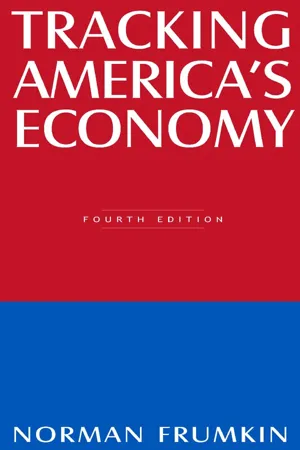Economics
Business Cycle and Economic Indicators
The business cycle refers to the recurring pattern of expansion and contraction in an economy. It typically consists of four phases: expansion, peak, contraction, and trough. Economic indicators are statistics that provide insight into the current and future health of the economy, such as GDP, unemployment rate, and consumer confidence. These indicators help to track and analyze the business cycle.
Written by Perlego with AI-assistance
Related key terms
7 Key excerpts on "Business Cycle and Economic Indicators"
- eBook - ePub
- Les Ruddock(Author)
- 2008(Publication Date)
- Routledge(Publisher)
from the short to the long term with an analysis of building cycles.Business cycles
Fluctuations in levels of economic activity are quite common in developed countries. These movements are known as business cycles. A business cycle usually has four distinct phases: the upswing or recovery phase, the peak, the downswing phase and the trough. In the US, reference is often made to expansions or contractions in economic activity. Business cycles are said to be recurring, but not periodic (i.e. not perfectly regular). A distinction is often made between classical business cycles and growth cycles (Mintz, 1974; Zarnowitz, 1985, 1992; Boehm, 1990; Cloete, 1990; Klein, 1990; Mankiw, 1990). When gross domestic product declines in absolute terms from peak to trough, it is known as a classical cycle. Growth cycles are identified by variations in the rate of growth of gross domestic product. As economies developed rather rapidly in the post-war period, growth cycles predominated. The duration of business cycles normally varies from 3 to 7 years, measured from peak to peak or from trough to trough. Sometimes, however, they can last for a decade, as was the case in the US during the 1990s (Zarnowitz, 1999).Quantitative leading economic indicators
Origins of quantitative leading indicators
Quantitative leading economic indicators form part of a system of leading, coinciding and lagging indicators developed by the National Bureau of Economic Research (NBER) in the US. This system is often referred to as the ‘NBER methodology’. It consists of a scoring system for the assessment and selection of economic indicators. Sometimes, it is referred to as the ‘business cycle indicators approach’. Development of this methodology can be traced back to the early works of writers such as Arthur F Burns and Wesley C Mitchell (1946). In his recent book, Alan Greenspan (2007: pp. 184–185) mentions that Burns was one of his predecessors at the US Federal Reserve and described him as ‘an economist who did groundbreaking work on business cycles’. The initial work was followed up by Geoffrey Moore, Julius Shiskin, Victor Zarnowitz, Charlotte Boschan, Philip Klein, Kajal Lahiri, Anirvan Banerji and others who continued the research, further developing and refining the selection, scoring and compilation of leading economic indicators. This method of business cycle research, or variations on the theme, is currently being used in most developed countries for the analysis of economic conditions and prospects. - eBook - ePub
- Norman Frumkin(Author)
- 2015(Publication Date)
- Routledge(Publisher)
1 Attributes of Economic Indicators The statistics central to evaluating and forecasting the macro economy of the United States are often referred to as economic indicators. This chapter discusses several conceptual and statistical topics that underlie the indicators: business cycles, determining cyclical turning points, seasonality, index numbers, data accuracy, calculating and presenting growth rates, price-adjusted dollars, the underground economy, distinctions among “goods,” “services,” and “structures,” the production of economic statistics, and data integrity. BUSINESS CYCLES Business cycles are the recurring rises and falls in the overall economy as reflected in production, income, employment, sales, profits, and prices. They are associated with capitalistic societies in which production, employment, prices, wages, and interest rates are largely determined in the marketplace. They are primarily associated with industrially advanced nations that have highly developed business and financial structures, in contrast to developing nations that have a large agricultural component that is subject to the vagaries of weather and the consequent abundant or poor harvests. Business cycles reflect the inability of the marketplace to accommodate smoothly such factors as shifting markets for new and substitute products, new technologies, uncertainties and risks in business investments, stock market speculation, global competition and currency volatility, terrorism, and shortages and gluts created by wars (including their buildups and aftermaths), weather-dependent harvests, and the manipulation of supplies and prices by cartels. Economists have offered various theories to explain the causes of business cycles in the past, and they continue to provide varying explanations today. 1 The theories are tested empirically against the movements of the relevant economic indicators to determine how well the theories conform to the data - eBook - ePub
Macroeconomics
(With Study Guide CD-ROM)
- Jagdish Handa(Author)
- 2010(Publication Date)
- WSPC(Publisher)
CHAPTER 16 Business Cycles, Crises, and The International Transmission of Economic ActivityBusiness cycles are periodic fluctuations in economic activity. While the magnitudes of almost all economic variables fluctuate over time, the most significant variables for defining the business cycle are fluctuations in output and employment. The business cycle consists of a trough, upturn, peak, and downturn — followed by a trough and so on. In a growing economy, recessions tend to have a much shorter duration — usually of about six quarters to two years — than booms, which are often longer than six years.Macroeconomics investigates the causes of business cycles and whether monetary and fiscal policies can eliminate or moderate business cycle fluctuationsBusiness cycles are periodic fluctuations in economic activity. To describe a typical business cycle, we can start with its phase when economic activity is increasing. This upturn/expansion in economic activity culminates in a peak. The peak is followed by a downturn/contraction in economic activity. The downturn reaches a bottom, which is called the trough. The trough is a turning point for economic activity, which then starts a new upturn, which becomes the beginning of a new cycle. Therefore, the business cycle has four phases: upturn/expansion, peak, downturn/contraction, and trough. Note that the description of the business cycle could have been given starting with any one of these phases. The peak and the trough are called the ‘turning points’ of economic activity. The duration of a business cycle can be measured from one peak to the next one or from a trough to the next one.Business cycles can be defined in two different ways: 1. They can be defined in terms of absolute movements in economic activity. To illustrate, under this definition, the downturn would be a decrease in output and employment.2. For a growing economy, it can be defined as the movement around the trend level of economic activity. In this case, the downturn would be a decline in the growth rates of output and employment from their trend levels, even if there is no absolute decline in these variables. - eBook - ePub
Economics for Investment Decision Makers
Micro, Macro, and International Economics
- Christopher D. Piros, Jerald E. Pinto(Authors)
- 2013(Publication Date)
- Wiley(Publisher)
Solution to 6: B is correct. Leading indicators can help predict short-term trends but are not as useful in predicting long-run returns on equity. The changing nature of an indicator itself reduces its usefulness to investors.6. SUMMARY
This chapter has summarized business cycle analysis. Among the points made are the following:- Business cycles are a fundamental feature of market economies, but their amplitude and length vary considerably.
- Business cycles have four phases: trough, expansion, peak, and contraction.
- Keynesian theories focus on fluctuations of aggregate demand (AD). If AD shifts left, Keynesians advocate government intervention to restore full employment and avoid a deflationary spiral. Monetarists argue that the timing of government policies is uncertain and it is generally better to let the economy find its new equilibrium unassisted, but to ensure that the money supply is kept growing at an even pace.
- New classical and real business cycle (RBC) theories also consider fluctuations of aggregate supply (AS). If AS shifts left because of an input price increase or right because of a price decrease or technical progress, the economy will gradually converge to its new equilibrium. Government intervention is generally not necessary because it may exacerbate the fluctuation or delay the convergence to equilibrium. New Keynesians argue that frictions in the economy may prevent convergence, and government policies may be needed.
- Stephan Leimberg, Robert J. Doyle, Michael S. Jackson, Martin J Satinsky(Authors)
- 2019(Publication Date)
- The National Underwriter Company(Publisher)
If consumer demand would grow at a relatively constant sustainable rate, there would be far fewer fluctuations in economic activity and little or no business cycle. So why does consumer demand fluctuate?Several statistical series are especially indicative of consumer demand, including the CPI, auto sales, consumer credit, and housing starts.As noted above, each expansion sows the seeds of the following recession because every expansion is fueled by credit. Consumers and businesses borrow to buy new homes, cars, factories, and machinery. The more they borrow and spend, the faster demand grows, pushing production into higher gear in order to keep pace with demand. But sooner or later, the upward spiral of borrowing and spending comes to an end. The strain on productive capacity forces costs higher, pushing up prices. Inflation depresses consumer sentiment and consumers respond by curtailing their expenditures. Consumers also find that their incomes cannot support the burden of additional debt repayment. Businesses, having accomplished their targeted growth in plant and equipment, cut back or cease their expenditures in this area. Once business and consumer borrowing and spending start to decline, the slump begins and production and income falls. Subsequently, inflation subsides with the drop in demand. Debt is repaid. As the demand for borrowing declines, the cost of borrowing (interest rates) also declines. Businesses that have cut back on production eventually begin to deplete their inventories. With lower borrowing costs and generally lower relative materials prices and wages, producers ultimately must increase production to meet demand. Jobs increase, layoffs are called back to work, consumer sentiment rises, and with it, consumer spending. The cycle is ready to repeat itself.1. Consumer Price Index (CPI). The fluctuations in the CPI chart the course of inflation. Lower inflation leads to improved consumer sentiment and demand, which drives economic expansion forward.The CPI measures relative price changes over time. The CPI is calculated by compiling a list of goods and services purchased by the typical consumer, including such items as food, clothing, shelter, public utilities, and medical care, which make up a market basket. The price of each item is recorded and assigned a weight according to its relative importance in the basket. Changes in the prices of each item are noted and the percentage change in the total price is reflected in the change of the index number.- eBook - ePub
Analyzing Modern Business Cycles: Essays Honoring
Essays Honoring
- Philip A Klein(Author)
- 2017(Publication Date)
- Routledge(Publisher)
Chart 4.3 depicts the behavior of the FRB's industrial production index for manufacturing as a whole. Official business cycle peaks and troughs are indicated as well. The data are plotted logarithmically to reflect rates of change. It is clear that manufacturing production is better behaved during expansions than contractions. Production usually slows as expansions mature. But in recessions, the steepest rates of decline sometimes occur early in the downturn and sometimes late. Adjustment paths during recessions are diverse, suggesting—not unlike the theory of chaos just beginning to be applied to economics—that adjustment processes are complex once the economy turns down. This likelihood is, in fact, suggested by the leading indictor index which exhibits very short leads, if any, at troughs.Chart 4.3 . Industrial Production—Manufacturing.A Summary Indicator Based on Business Cycle Dynamics
As a result of the business cycle dynamics described here, there should be considerable informational content in production, inventory, and orders variables relating to the manufacturing sector. Variables for this sector are, in fact, well represented in the list of leading indicators. Six of the eleven leading indicators are so related; they are:- New orders received by manufacturing, consumer goods and materials, 1982$;
- Contracts and orders, plant and equipment, 1982$;
- Average work week of production workers, manufacturing;
- Vendor performance; percentage of companies receiving slower delivery;
- Change in sensitive materials prices, percentage;
- Change in manufacturing inventories on hand and on order, 1982$.
The six leading indicators reflect various aspects of demand for manufactured goods. All manufacturing orders are reflected in the indicators—those for consumer goods, for materials, and for capital equipment. All unfilled orders are inventories measured in the "on hand or on order" indicator. Unfilled orders are also reflected in the vendor performance indicator. Average weekly hours of manufacturing workers is a proxy for manufacturing production. Changes in production are associated with a change in the work week and/or a change in employment. Typically, hours are adjusted before workers are hired or laid off. Sensitive prices reflect largely those of unprocessed or very partially processed commodities, which are affected by demand before prices at a later stage.3 - eBook - ePub
Use of Survey Data for Industry, Research and Economic Policy: Selected Papers Presented at the 24th CIRET Conference, Wellington, New Zealand 1999
Selected Papers Presented at the 24th CIRET Conference, Wellington, New Zealand 1999
- Karl Heinrich Oppenlander, Gunter Poser, Bernd Schips(Authors)
- 2018(Publication Date)
- Routledge(Publisher)
Among the quantitative indicators, we find that 5 of the 6 exhibit one extra cycle during the 5 expansions of traditional length analyzed over the 50 years covered. None has more than one. Further, the average frequency with which one may encounter extra cycles from the quantitative indicators is no more than 2 during the three long expansions. For the six qualitative indicators we also find that extra cycles are generally no more frequent during the traditional expansions than was the case for the quantitative indicators (there is one exception). However, during the long expansions, the picture is radically and consistently different. Extra cycles are far more prominent among the qualitative indicators over long expansions. In fact, they average four times as frequent. One might attribute greater volatility to the fact that qualitative indicators are sensitive to the changing psychological perceptions of economic agents. The findings in this study are widespread and cover too long a period to be due to random factors.Table 6.3 Number of Extra Cycles in Three Long Expansions and in Seven Average Expansions, Quantitative and Qualitative IndicatorsFigure 6.1 Quantitative Leading Indicators (Levels of Economic Activity)Figure 6.2 Qualitative Leading Indicators (Levels of Economic Activity)3 Qualitative Indicators and Growth Rate Cycles
Leading indicators were originally designed to anticipate classical recessions or sustained periods of absolute decline in economic activity. In the 1960s, however, recessions were few and far between and the cycle manifested itself as a period of faster growth interrupted by bouts of slower growth. Such cyclical behavior became known as ‘growth cycles’ as opposed to ‘classical cycles’. Subsequently, there was a move among business cycle students in many countries to study the growth cycle. The international economic indicators (EI) project (Klein and Moore, 1985) started at the NBER in the 1970s. The move was precipitated by Use Mintz’s pioneering study of post-war German cycles (Mintz, 1969), in which she demonstrated the usefulness of growth cycle analysis, based on deviations from trend in economic activity. (Today the OECD, among others, monitors growth cycles for member countries.) We underscore that the calculation of the underlying trend is critical, particularly for the recent past, which is critical for forecasting. These trends, however, are difficult to measure accurately on a real-time basis (Boschan and Banerji, 1990) and are subject to revision (Cullity and Banerji, 1996). They are, therefore, especially suspect when used in forecasting which depends critically on deviations from the most suspect part of the trend - the recent past. To solve this problem, Moore began to use growth rate cycles for the measurement of series which manifested few actual cyclical declines, but did show cyclical slowdowns (Layton and Moore, 1988). Moore’s ‘six month smoothed growth rate’ concept eliminated the need for extrapolation of the past trend in growth cycle analysis. We now call cycles calculated by this method growth rate cycles. For monthly data, the calculation is based on the ratio of the current value of the series to its average during the previous 12 months, expressed as an annual rate by raising to the 12/6.5 power. (For quarterly series, the calculation is the ratio of the current quarter to the average of the proceeding four quarters raised to the 4/2.5 power.) These rates are much smoother than those based on monthly or quarterly changes. Growth rate cycles are episodes in which the overall amplitude of the phase percent change is ‘large’. But the comparison is in terms of smoothed growth rates and so is relative to all the phase amplitudinal changes being examined without any necessity to achieve an arbitrary threshold amplitude change such as the underlying trend as one needs to do in growth cycle analysis. In his extensive study of Swedish business cycles, Klein demonstrated that the growth rate cycle is another effective way to monitor slowdowns (Klein 1998). It has the advantage that peaks in growth rate cycles occur before business cycle peaks—that is, economic activity slows down before it turns down and therefore aids in forecasting potential business cycle developments.
Learn about this page
Index pages curate the most relevant extracts from our library of academic textbooks. They’ve been created using an in-house natural language model (NLM), each adding context and meaning to key research topics.






